
|
|
|---|
Monday, May 31, 2010
tribal wing tattoos - tips for new tattoo
You have decided that you want a tribal wing tattoos but you aren't necessarily sure how to start your research. This type of tattoo has become quite popular with tribal tattoo lovers. But before you head down to your local tattoo parlour and drop your hard earned money, you may want to do some research first. The truth is this research can mean the difference between a great tattoo that you're happy with or a disappointing tattoo. Would you like to know more?
My biggest concern is that I don't want you to do what everyone else does and that is start your research for artwork by using Google images. Google images isn't a bad place for ideas, but because everyone uses this method you run the risk of duplicating someone else's tattoo. And I am sure that isn't what you want.
The best piece of advice I can give you is to invest in a paid tattoo site. A paid tattoo site gives use so many resources before you get your tattoo. You will gain access to artists that specialize in tribal tattoo artwork. You can work with one of these artists to come up with something unique for your new ink. You also gain access to a huge community of tattoo enthusiasts that will be able to answer any questions or concerns you may have. These paid tattoo sites also have reviews of local tattoo parlors so you can find the right parlor for your new tribal tattoo.
Sunday, May 30, 2010
"...Star differs from star in glory..."

(Vincent Van Gogh, "Starry Night over the Rhone," 1888)
I Corinthians 15:40-44:
"There are both heavenly bodies and earthly bodies, but the glory of the heavenly is one thing, and that of the earthly is another. There is one glory of the sun, and another glory of the moon, and another glory of the stars; indeed, star differs from star in glory. So it is with the resurrection of the dead. What is sown is perishable, what is raised is imperishable. It is sown in dishonor, it is raised in glory. It is sown in weakness, it is raised in power. It is sown a physical body, it is raised a spiritual body. If there is a physical body, there is also a spiritual body."
I had a magnificent set of evenings over Memorial Day weekend sitting out among the moon and the stars--even sleeping out all night in my yard one night, it was so glorious--and seeing the lightning bugs begin their summer debut for the season. It was simply a magnificent weekend to be a speck in God's Universe. The sheer size and awesome timelessness of the "big" things in nature--the sky, the stars, the ocean, just to name a few--have always been the major spiritual grounding rods for me, my entire life. People just don't do it for me the way nature does.
I looked at the stars these last few nights and pondered the paradoxical dance that "people" seem to occupy in my existence, thinking how each star, in its own way, is its own "person." How like the stars in the sky, we are called to community, and how each of us in our own way feels called to individuals in that community. Yet for me, the paradox has always been nothing gets my goat like people sometimes. I can only handle people for so long, and then that secular monastic in me takes over and I retreat to my safe hermitage of my country life. There is my daily retreat from work, as well as "add on" forms like my occasional "silent Saturday morning," and my "stay-cation retreats where I never leave home." Yet I never feel "un-called" to be a part of a community. When I am home alone, after a certain amount of time enjoying my alone-ness, I think of what it is I am supposed to "do next" when I enter back into community. When I am in that community, after a while I start daydreaming of what I want to do next in my "alone time." Each needs the other, and truthfully, each feeds the other.
On one of those nights, I sat out and thought about different people with each star--what they were experiencing in their lives, and how it is that I am supposed to combine with them to light up the sky, yet maintain my own individual "star-ness." Each one of us with the incarnational light of God within us, but manifested in so many unique ways.
There seem to be at least three kinds of stars in my life experience. Most valued are the "stars I can always see"--for instance, in the winter, I can always find the constellation Orion, and in the summer I can always fix my gaze on Scorpio. They are like the people in my life who have now been my friends for three decades or more. How we relate to each other has changed drastically over the years--sometimes not even close to the roles in which our relationships started out--but we somehow can always adjust. Sometimes their light is very intense and intimate in my life, and vice versa; other times, the light is dimmer. But they are constants. They are appreciated for both their longevity and their versatility.
Then there are the stars that once were a major focus, but I now no longer pay much attention to. I really don't pay much attention to the Big Dipper, the Little Dipper, or the North Star itself, per se. But there was a time I always looked for them. They are like the people who were once very involved and intimate in my life--old lovers, intense best friends, etc.--and somehow no longer figure much into the tapestry other than to be a thread once cherished, but no longer. Some of these fizzled out in a supernova of conflict, whereas others just sort of atrophied and slowly burned to extinction. Sometimes their light returns--but it is almost never of the same intensity that it once was, nor does my need to tend to that light return with the same intensity. I appreciate those stars for the history they have given me, even if it includes hard lessons.
Finally, there are the stars I just got around to noticing, like the time I first recognized all of Ursa Major, rather than just its "dipper." The first time I realized the dipper could be converted to a bear, it was an exciting time. It made the sky seem a little bigger than it used to be. I think about the gifts and talents in people I just now got around to appreciating in people who have been around me all along, or about the new people that come into my life over the years, and something about them challenge me to tend their light and let them tend mine. I appreciate those stars because they represent hope and promise.
Even the stars are perishable--which enhances my knowledge that people are perishable. It makes me understand the urgency of the Gospel of Mark, and in Paul's letters. If even stars are perishable, then people definitely are. Yet timelessness and infinity rides within all of them. What a beautiful, but messy, dance it all is!
Saturday, May 29, 2010
Friday, May 28, 2010
That Mysterious Critter called the Trinity

In that odd way that only people who have worked around a hospital can appreciate, I have found the fact that Trinity Sunday coinciding with Memorial Day Weekend (Or, as I like to call it, "Opening day of major trauma season,")--rather amusing.
I've got a confession. I find thinking about the Trinity too long, rather traumatic. My clergy Facebook friends find preaching about the Trinity on Trinity Sunday rather traumatic. Most of them refer in some way that it is a week where they feel compelled to teach those in the pews about the Trinity, and have to admit they really don't understand much about the Trinity.
Now, I can handle the diagram above. It's pretty straightforward and simple. I recognize God is in all three entities, and each of the three entities are not in each other--well...sorta. One person told me in a recent discussion, "I know I'm not my brother and I know I'm not my sister, but the family DNA is in all of us." That is kind of what the diagram parallels. I agree with all of that. But that's where it ends.
Here's my heresy...
I have this nagging feeling that the Trinity is a representational being--like the wave or particle theory of light. Although I would be the first to tell you that the Trinity and the statements in the Nicene Creed (well, except for that add-on about proceeding from the Father AND the Son--the Son half of the filioque was tacked on later to the Creed) are "true," I would tell you I think the reality lies behind the Trinity, and the Trinity is what we use to explain what is actually a single entity made of infinite parts.
For instance...
Light, in some ways, behaves like a wave. In other ways, it behaves like a particle. Odds on, it's something that is neither or both a wave or a particle. But we can function in our world, make great discoveries and inventions involving the spectrum of light, by acting like it is a wave when it's useful and convenient, and acting like it's a particle when it's useful and convenient. The fact that it probably is NOT exactly what we theorize it to be isn't relevant. We don't sit and bemoan that it's not "true." Truth is perception, more than anything.
But the fact that the Hebrew Bible has between 40 and 70 words (depending on which rabbi you consult) that describe one aspect of what Christians attribute to a function of the Holy Spirit, or God the Father, or the Messiah, makes me suspicious that the Trinity is to Christian thought what the wave or particle theory is to light--a representation we can wrap our brains around, at least to a basic degree, that allow us to be connected relationally to God, and not just function in that world, but imagine, invent, and share with others in community.
Did you ever notice humans, by and large, no matter what their culture, like "threes?" We like to think bad news comes in threes. We tend to use threes in literature, in our phraseology. Many things in science, if you repeat them three times, creates a greater than two standard deviations level of confidence, statistically. We tend to only start to "get" things after the third time we've experienced something. We say, "three's a charm." I used to think that was a function of Judeo-Christian culture, until I learned that many other religions--Hinduism, Buddhism, Paganism, ancient Celtic religion, ancient Norse religion, etc.--also have many examples of the significance of the number three.
My theory--and that's all it is--is that for some reason, humans brains are hard-wired to be ok with three. Maybe it is because it's simply one more than what we can grasp in our own two hands. It's manageable. So when the Trinity was being "figured out," people like the folks who came up with the Nicene Creed sat there pondering this God with infinite faces and forms, and gravitated to explaining it in an iconic representation that is the default human level of understanding--three.
So for me, the Trinity is simply a three-pronged representation of an infinite concept--and here is where some people are going to shove me into the Express Lane to Hell for saying this, but I'm going to say it anyway--the Trinity seems to me to be more of a functional theory than an actual fact. There is truth in it, but the truth actually lies BEHIND it, not IN it, and I am willing to accept the "model" because it allows me to function in my world of "understanding my relationship with God." To accept the Trinity as "truth" also means I must accept the mystery that it is a representation of a bigger reality that I cannot possibly understand.
It's why I don't trust anyone who claims he/she can "explain" the Trinity to me. I think part of accepting the truth of the Trinity is to also accept that my brain, in my living human form, cannot possibly understand it, but I can understand enough of it to function as one of God's children within the confines of what it represents. To say "I believe in the Trinity"--to say the Nicene Creed and mean what I say--means I believe the reality it represents is only fully fathomable in the next world.
I'll be honest--this is a hard realization for me. I like to think I'm smart enough to "figure most everything out." But to accept that I cannot possibly figure this one out, is to accept another part of my life as a child of God--faith. Faith that this representation can take me everywhere I need to go, to live in service to God--and in that, I believe.
Kanji Tattoos designs for girls | unlimited tattoo

Japan:Kanji Tattoo Symbols
Thursday, May 27, 2010
wrist tattoos for girls | designs tattoo
This is a cool tattoo owned by i'mcool said:it means a lot to me and i've wanted it for a long time now. i'm so happy that i've finally done it.
(this is for every person that plays an important role in my life.
and it is also to remind myself that when there is no one else there i have the strength within myself.....corny.....but true.)
And here are more tattoos on wrist.
wrist Tattoos for women
pictures of wrist tattoos .
Tattoos on wrist
extream tattoos for girls | tattoos girls
 Cobra tattoo designs image@istockphoto.com
Cobra tattoo designs image@istockphoto.comDo you love snake tattoo?If you love the awesome snake tattoo, you must love the king cobra tattoo!Right.The cobra tattoo is really cool!Here are some cobra tattoo pictures for you.If you want to have a new tattoo, you may consider this if you want.But, before you do this tattoo, should know the meaning of cobra tattoos!
tribal Cobra tattoo designs
 tribal Cobra tattoo image@deviantart.com _by_shwokeeshplat
tribal Cobra tattoo image@deviantart.com _by_shwokeeshplat What's the meaning of Cobra Tattoo ?
What's the meaning of Cobra Tattoo ?The meaning of Cobra Tattoos:they embodied such women’s characteristics as mysteriousness, intuition and unpredictability. For men a cobra means power and wisdom, but it is also a sign of insidiousness, slyness and darkness. Such tattoo can mean protectiveness over the people whose initials are inked or it can be a tattoo made in loving memory of those who are gone that shows that the tattoo owner will never forget them.

tribal temporary tattoos
Wednesday, May 26, 2010
Michael Angelo’s Amazing Paintings On The Sistine Chapel
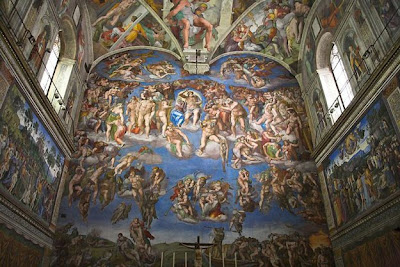
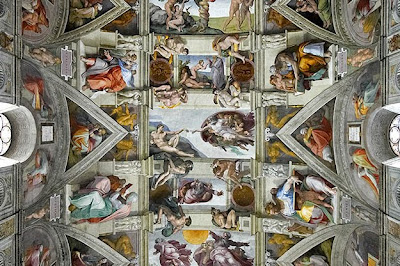
His stay in the Ghirlandaio shop must also have coincided with his beginning to work as a sculptor in the Medici Garden, where antiques from their collection were looked after by Bertoldo. Although this connection drew him into the Medici circle as a familiar, the account by Vasari of an established 'school' is now discredited. It must, however, have been Ghirlandaio who taught him the elements of fresco technique, and it was probably also in that shop that he made his drawings after the great Florentine masters of the past (copies after Giotto and Masaccio; now in the Louvre, in Munich, and in Vienna). Michelangelo produced at least two relief sculptures by the time he was 16 years old, the Battle of the Centaurs and the Madonna of the Stairs (both 1489-92, Casa Buonarroti, Florence), which show that he had achieved a personal style at a very early age.
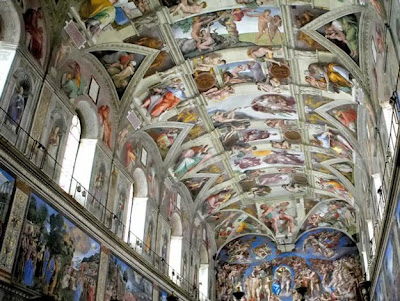
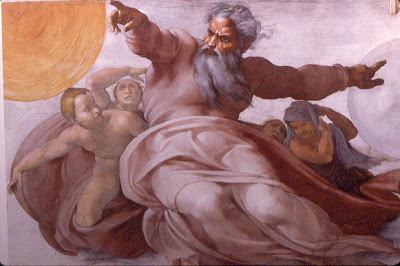 In Rome he carved the first of his major works, the Bacchus (Florence, Bargello) and the St Peter's Pietà, which was completed by the turn of the century. It is highly finished and shows that he had already mastered anatomy and the disposition of drapery, but above all it shows that he had solved the problem of the representation of a full-grown man stretched out nearly horizontally on the lap of a woman, the whole being contained in a pyramidal shape.
In Rome he carved the first of his major works, the Bacchus (Florence, Bargello) and the St Peter's Pietà, which was completed by the turn of the century. It is highly finished and shows that he had already mastered anatomy and the disposition of drapery, but above all it shows that he had solved the problem of the representation of a full-grown man stretched out nearly horizontally on the lap of a woman, the whole being contained in a pyramidal shape. 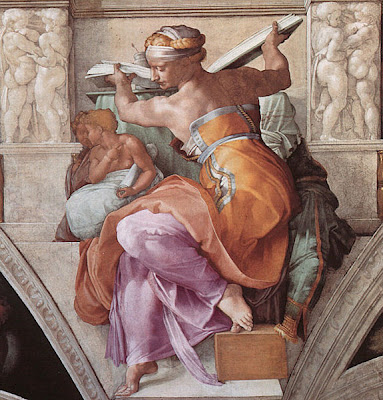



 Meanwhile, the original quarrel of 1506 with Julius was made up and Michelangelo executed a colossal bronze statue of the Pope as an admonition to the recently conquered Bolognese (who destroyed it as soon as they could, in 1511). In 1508, back in Rome, he began his most important work, the ceiling of the Sistine Chapel in the Vatican for Julius, who, as usual, was impatient to see it finished. Dissatisfied with the normal working methods and with the abilities of the assistants he had engaged, Michelangelo determined to execute the whole of this vast work virtually alone. Working under appalling difficulties (amusingly described in one of his own poems), most of the time leaning backwards and never able to get far enough away from the ceiling to be able to see what he was doing, he completed the first half (the part nearer to the door) in 1510. The whole enormous undertaking was completed in 1512, Michelangelo being by then so practised that he was able to execute the second half more rapidly and freely. It was at once recognized as a supreme work of art, even at the moment when Raphael was also at work in the Vatican Stanze. From then on Michelangelo was universally regarded as the greatest living artist, although he was then only 37 and this was in the lifetimes of Leonardo and Raphael (who was even younger). From this moment, too, dates the idea of the artist as in some sense a superhuman being, set apart from ordinary men, and for the first time it was possible to use the phrase 'il divino Michelangelo' without seeming merely blasphemous.
Meanwhile, the original quarrel of 1506 with Julius was made up and Michelangelo executed a colossal bronze statue of the Pope as an admonition to the recently conquered Bolognese (who destroyed it as soon as they could, in 1511). In 1508, back in Rome, he began his most important work, the ceiling of the Sistine Chapel in the Vatican for Julius, who, as usual, was impatient to see it finished. Dissatisfied with the normal working methods and with the abilities of the assistants he had engaged, Michelangelo determined to execute the whole of this vast work virtually alone. Working under appalling difficulties (amusingly described in one of his own poems), most of the time leaning backwards and never able to get far enough away from the ceiling to be able to see what he was doing, he completed the first half (the part nearer to the door) in 1510. The whole enormous undertaking was completed in 1512, Michelangelo being by then so practised that he was able to execute the second half more rapidly and freely. It was at once recognized as a supreme work of art, even at the moment when Raphael was also at work in the Vatican Stanze. From then on Michelangelo was universally regarded as the greatest living artist, although he was then only 37 and this was in the lifetimes of Leonardo and Raphael (who was even younger). From this moment, too, dates the idea of the artist as in some sense a superhuman being, set apart from ordinary men, and for the first time it was possible to use the phrase 'il divino Michelangelo' without seeming merely blasphemous.  The Sistine Ceiling is a shallow barrel vault divided up by painted architecture into a series of alternating large and small panels which appear to be open to the sky. These are the Histories. Each of the smaller panels is surrounded by four figures of nude youths - the Slaves, or Ignudi - who are represented as seated on the architectural frame and who are not of the same order of reality as the figures in the Histories, since their system of perspective is different. Below them are the Prophets and Sibyls, and still lower, the figures of the Ancestors of Christ. The whole ceiling completes the chapel decoration by representing life on earth before the Law: on the walls is an earlier cycle of frescoes, painted in 1481-82, representing the Life of Moses (i.e. the Old Dispensation) and the Life of Christ (the New Dispensation). The Histories begin over the altar and work away from it (though they were painted in the reverse direction): the first scene represents God alone, in the Primal Act of Creation, and the story continues through the rest of the Creation to the Fall, the Flood, and the Drunkenness of Noah, representing the human soul at its furthest from God. The whole conception owes much to the Neoplatonic philosophy current in Michelangelo's youth in Florence, perhaps most in the idea of the Ignudi, perfect human beauty, on the level below the Divine story. Below them come the Old Testament Prophets and the Seers of the ancient world who foretold the coming of Christ; while the four corners have scenes from the Old Testament representing Salvation. The Prophet Jonah is above the altar, since his three days in the whale were held to prefigure the Resurrection. On the lowest parts - and very freely painted - are the human families who were the Ancestors of Christ. There can be no doubt that the splendour of the conception and the size of the task distracted Michelangelo from the Tomb, but he at once returned to it as soon as the ceiling was finished, from 1513 to 1516, when he returned to Florence to work for the Medici. (For details on the frescoes in the Sistine Chapel take a guided tour.)
The Sistine Ceiling is a shallow barrel vault divided up by painted architecture into a series of alternating large and small panels which appear to be open to the sky. These are the Histories. Each of the smaller panels is surrounded by four figures of nude youths - the Slaves, or Ignudi - who are represented as seated on the architectural frame and who are not of the same order of reality as the figures in the Histories, since their system of perspective is different. Below them are the Prophets and Sibyls, and still lower, the figures of the Ancestors of Christ. The whole ceiling completes the chapel decoration by representing life on earth before the Law: on the walls is an earlier cycle of frescoes, painted in 1481-82, representing the Life of Moses (i.e. the Old Dispensation) and the Life of Christ (the New Dispensation). The Histories begin over the altar and work away from it (though they were painted in the reverse direction): the first scene represents God alone, in the Primal Act of Creation, and the story continues through the rest of the Creation to the Fall, the Flood, and the Drunkenness of Noah, representing the human soul at its furthest from God. The whole conception owes much to the Neoplatonic philosophy current in Michelangelo's youth in Florence, perhaps most in the idea of the Ignudi, perfect human beauty, on the level below the Divine story. Below them come the Old Testament Prophets and the Seers of the ancient world who foretold the coming of Christ; while the four corners have scenes from the Old Testament representing Salvation. The Prophet Jonah is above the altar, since his three days in the whale were held to prefigure the Resurrection. On the lowest parts - and very freely painted - are the human families who were the Ancestors of Christ. There can be no doubt that the splendour of the conception and the size of the task distracted Michelangelo from the Tomb, but he at once returned to it as soon as the ceiling was finished, from 1513 to 1516, when he returned to Florence to work for the Medici. (For details on the frescoes in the Sistine Chapel take a guided tour.) 


.jpg)
.jpg)












 Back Japanese Tattoo |
Back Japanese Tattoo | 